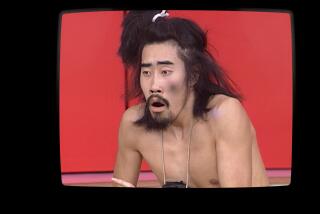A Second Look: Japan’s slasher ‘House’ moves into U.S.
- Share via
After the international success of “Jaws” in 1975, executives at Japan’s venerable but then-struggling Toho Studios approached Nobuhiko Obayashi, a leading director of commercials, and invited him to make the Japanese equivalent. The resulting film, 1977’s “House,” bears no discernible resemblance to “Jaws,” though like the Steven Spielberg classic, it’s surely some kind of benchmark for its genre — if this freakish, garish spasm of surrealist-psychedelic horror-comedy can be said to belong to a genre at all.
Brainstormed with his 11-year-old daughter, Chigumi (who gets story credit), “House” is one of the most enduringly — and endearingly — weird cult movies of the past few decades. Preceded by its reputation for years among Japanese-pop and midnight-movie aficionados, it received a belated opening in select theaters a few months ago and is being released by the Criterion Collection in standard-definition DVD and Blu-ray editions this week.
The movie’s heroine, Gorgeous (Kimiko Ikegami), throws a tantrum when her widowed film-composer father returns from a work trip with a new fiancée in tow. Jealous and hurt, Gorgeous makes alternate plans for summer vacation, rounding up a group of instructively nicknamed friends — Prof (bespectacled), Melody (musical), Kung Fu (sporty), Fantasy (dreamy), Sweetie (nice) and Mac (chubby) — to accompany her on a visit to her late mother’s sister.
On the journey there, Gorgeous shares the sad tale of her spinster aunt, who lost her fighter-pilot lover during the war. Upon their arrival, the aunt, who has a creepy white cat with laser-beam eyes, proves to be not all there, and the slasher-movie routine kicks in. The plot, such as it is, may be familiar, but the methods of disposal are anything but. The first victim is reduced to a decapitated head (or perhaps turned into a watermelon?), which attaches itself to the posterior of another girl.
One could make psychological sense of the film’s nightmarish absurdities. Gorgeous’ daddy issues frame the story, which can be seen as an expression of psychosexual coming-of-age anxiety. But the true meaning of “House” is to be found in its style — or, more to the point, its crazy superabundance of style. Not only does Obayashi pull out every technique in the book — freeze frames, slow motion, jump cuts, zooms, irises, superimpositions — he does so incessantly and often for no apparent reason. He’ll imitate a silent movie at one point, throw in some crude animation at another. And to add to the head-splitting effect, the busy, lite-jazzy soundtrack often seems to have strayed in from two or three entirely different movies.
Nominally classified as horror, “House” has some affinities with the work of Italian “giallo” schlockmeisters Dario Argento and Mario Bava, and it anticipates the wackier experiments of Japanese genre-benders such as Takashi Miike. But “House,” an insistently cartoonish and synthetic collage, is further removed from reality than even the most surreal of horror movies, and it might be more apt to consider its lineage in relation to Obayashi’s dual background in experimental film and commercials.
Obayashi started his career making avant-garde shorts in late ‘50s Tokyo (where his circle included Yoko Ono). One of his early films, the 40-minute “Emotion” (1966), heavily influenced by the knowing cinephilia and anything-goes energy of the French New Wave, is included on the Criterion disc. He was offered commercial assignments on the basis of his vibrant experimental work. By the time Obayashi made “House,” he had established himself as a top adman, and in his commercials (such as a series of cologne ads featuring Charles Bronson), he cultivated a style that was near parodic in its tendency toward stylistic exaggeration.
Obayashi, now 72, has made nearly 40 movies since “House,” only a few of which have received international attention (among them, 1998’s “Sada,” based on the true story of sexual passion that inspired Nagisa Oshima’s “In the Realm of the Senses”). By all accounts, his later work never approached the unhinged delirium of “House,” but he has enjoyed a long career as a director of pop-oriented films. This is one filmmaker for whom a youthful perspective is paramount.
Explaining on the Criterion DVD why he collaborated with his pre-teen daughter, Obayashi says, “I always discuss important matters with children.”
More to Read
Only good movies
Get the Indie Focus newsletter, Mark Olsen's weekly guide to the world of cinema.
You may occasionally receive promotional content from the Los Angeles Times.










